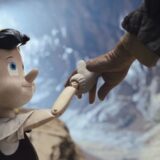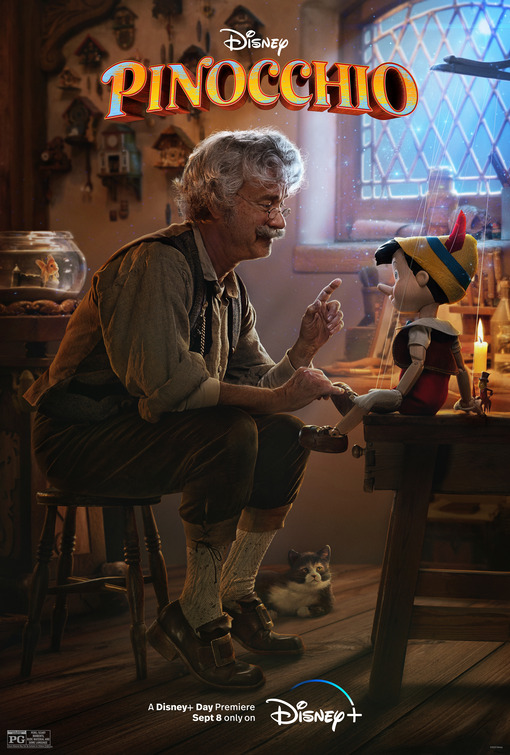
Movie Review: Pinocchio
What We Liked
What We Didn't Like
The latest in Disney’s interminable run of remakes, Robert Zemeckis’ Pinocchio is not a reimagining of the classic Carlo Collodi story or animated classic so much as a slick bit of content to pad out Disney’s streaming service. Pinocchio the puppet may have no strings, but Pinocchio the movie has no soul.
There certainly is room for another adaptation of the Pinocchio story — even as we await a stop-motion version from Guillermo del Toro later this year and just received one starring, um, Pauly Shore in 2021. Collodi’s novel is a more mischievous and dark take than Disney’s adaptation, and the story is ripe for exploration. Living in a world of AI and invisible helpers on our phones makes its ideas of humanity and reality more relevant, and the original animated film’s episodic structure provides avenues for a curious filmmaker to dig deeper into its themes of family, responsibility, heroism and morality.
But Zemeckis, working from an unimaginative script he co-wrote with Chris Weitz, seems disinterested in doing anything other than a paint-by-numbers regurgitation of the familiar tale, although he somehow adds an extra 30 minutes without bringing anything new of substance. Zemeckis, the director behind the classics Back to the Future (1985), Who Framed Roger Rabbit? (1989) and Cast Away (2001), has long since abdicated his role as a story-teller in favor of being a tinkerer obsessed with the latest digital tools. Like Geppetto, he devotes a great deal of time to crafting intricate and meticulous creations, but apparently the Blue Fairy never showed up to give this movie a spark of life.
The story slavishly follows the 1940 feature’s plot. Geppetto (Tom Hanks) is a lonely woodcarver, even more than in the original, as the story also saddles him with a dead wife and kid. He carves a puppet in the image of his late son and wishes on the first star he sees that he could have a child again (Jiminy Cricket helpfully explains that he has to carve a kid instead of making a real one because “Geppetto doesn’t get out much,” and have fun explaining that line to the tykes). That night, the Blue Fairy (Cynthia Erivo) brings the puppet to life — this version implies that Pinocchio has the soul of Geppetto’s dead kid — and charges talking bug Jiminy Cricket (Joseph Gordon-Levitt) with serving as the boy’s conscience. But it’s not long after that Pinocchio is lured away from school by a talking fox (Keegan-Michael Key) and embarks on a series of misadventures where he encounters a vicious puppeteer, the seductive but dangerous Pleasure Island, and the sea monster Monstro.
The film weaves through these beats in an obligatory fashion, making sure to hit all the landmarks in moments that meticulously recreate its 1940 counterpart’s most famous moments. There’s the iconic “When You Wish Upon a Star,” the jaunty “An Actor’s Life for Me” and Pinocchio’s charming “I’ve Got No Strings” number, as well as a few more musical moments that do nothing more than pad the runtime and serve as proof that while Tom Hanks may be one of the world’s most beloved actors, there’s a reason he’s never been asked to sing or dance. Zemeckis meanders through these moments dutifully but without much imagination, choosing instead to make his contributions to this new take an unending stream of Disney Easter eggs in two cuckoo-clock sequences and Pinocchio stopping to examine a lump of horse poop (at this point, it’s worth wondering whether the shot of Pinocchio staring at crap is meant as a metaphor for audiences watching this film).
Like Jon Favreau’s The Lion King, Pinocchio only serves as a reminder of how the beauty and magic of hand-drawn animation looks garish and unsettling when recreated in 3D. The animation is technically impressive and tactile, but aside from Pinocchio, all the computer-generated characters look cold and impassive, lacking the emotion and expressiveness of their 2D counterparts. It’s not as dead-eyed as Zemeckis’ The Polar Express (2004) and A Christmas Carol (2009), but it’s continued proof that animation is not necessarily improved upon by making it more realistic.
Not that the actors do much to enliven things. While Joseph Gordon-Levitt provides a pitch-perfect recreation of Cliff Edwards’ Jiminy Cricket, it’s nothing more than an impression, and the CGI bug has little of the charm of the original character. Lorraine Bracco slums it as a smart-alec seagull, and Key’s energy is smothered inside an inexpressive CGI character. Hanks turns in what might be the first bad performance of his storied career, mugging for the camera with a horrendous Italian (?) accent and engaging in pratfalls. It doesn’t help that he’s costumed with a goofy mustache and wig, which make him look silly even in moments where he’s supposed to be serious. Whether he did this for the generous Disney paycheck or as a favor to long-time collaborator Zemeckis, this might be the first time that Hanks appears to be phoning it in.
At 90 minutes, it’s easy to gloss over some of the original film’s plot imperfections, such as the fact that while Pinocchio’s nose growing when he tells a lie is meant as a punishment, it does help him get out of his scrape with Stromboli. At two hours and without the scrim of whimsy supplied by animation, it’s too easy to ask questions about why no one raises an eye about two fully clothed animals walking around an Italian village when Geppetto’s cat and fish appear to be traditional domesticated pets, or why the film tosses in a pointless subplot about a young ventriloquist with a prosthetic leg.

Benjamin Evan Ainsworth in “Pinocchio.” Courtesy of Disney Enterprises, Inc. – © 2022 Disney Enterprises, Inc. All Rights Reserved.
The 1940 film is best remembered, aside from “When You Wish Upon a Star,” for two sequences that inspired nightmares for entire generations: the chase with Monstro and Pinocchio’s hellish trip to Pleasure Island. Neither bit works in this version. Monstro is an afterthought who pops up quickly in the climax and then is dealt with without much trouble. Aside from a few added tentacles, he’s not particularly scary, and most kids will probably just think he escaped from a Pirates of the Caribbean sequel.
The Pleasure Island sequence is even more of a whiff. In the original, this was where Pinocchio’s mischievous nature finally caught up with him. He heads off with other rambunctious kids to an amusement park where they drink, smoke and raise a ruckus but don’t realize that they’re being seduced by their baser impulses and turned into literal jackasses. The Zemeckis version follows the template — don’t be surprised when Disney eventually turns the sugar-coated roller coaster ride into a theme park attraction — but without the teeth. Benjamin Evan Ainsworth’s Pinocchio is too sweet and precocious to be believable as a trouble-maker, and this Pleasure Island dispenses with any really bad behavior. There’s no smoking, the film explicitly mentions that the kids are drinking root beer, and all the shops give explicit permission for the kids to break and smash their stuff. It’s a bit scary to watch one kid turn into a donkey — mostly, again, because real life is more hideous than animation — but any moral lesson is lost because this Pinocchio isn’t so much mischievous as he is easily distracted.
From a technical point of view, this Pinocchio is not the worst of the Disney remakes, as it has a tad more warmth than The Lion King and Zemeckis delivers a few shots with some visual imagination. But it feels like the most disinterested in its story, more aware that it’s not meant to be a piece of art so much as another distraction to join the Disney+ lineup of babysitters. It shrugs off anything of emotional or thematic import, even going so far as to suggest that, hey, maybe Pinocchio didn’t even become a real boy at the end, probably because leaving open the possibility of him still being a puppet would make a sequel much more feasible.
But, it’s like the old song goes: “When you wish upon a star, maybe your dreams come true and maybe they don’t. But hey, thanks for subscribing and remember Disney+ subscription prices increase in December.”



